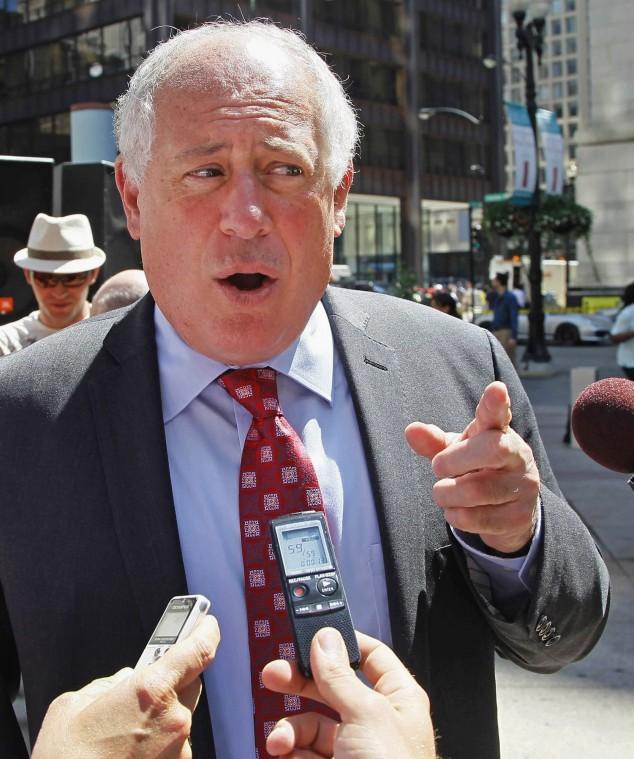State-run facility shutdowns will leave nearly 2,000 people jobless
The Associated Press: Pat Quinn talks with reporters outside the James R. Thompson Center in Chicago.
September 27, 2011
About 2,000 people will lose their jobs as a result of a recent shutdown of state-run facilities. Gov. Pat Quinn said he was forced to cut state-run mental health centers in order for Illinois to stay within budget and blamed the Illinois General Assembly for not coming up with an adequate budget.
Januari Smith, communication manager of the Illinois Department of Healthcare and Family Services (DHS), said the closures will save Illinois $45 million in 2012.
State Rep. Norine Hammond (R-Macomb) said the governor cannot simply close down these facilities overnight. The Commission on Government Forecasting and Accountability must review his decision.
Smith said the governor is concerned with providing people with community-based care but the General Assembly did not set aside enough funds for them to move these people from the facilities into community-based care. Community-based care would be an office in the community that takes appointments to see patients.
“DHS plans to reinvest an appropriate amount of the savings from closing these facilities into community care so that residents/patients will have a safe transition to community-based care and support in their new situations,” Smith said.
Barbara Cozzone Achino is president of the Parents Association and the mother of two boys who reside at Jack Mabley Developmental Center in Dixon. She said community-care does not work for her boys and she needs these facilities.
“I have tried community placement six times and it failed and this budget cut also affects community providers,” Achino said. “Without enough funding they will not be able to provide services for our 91 individuals. Our individuals have special needs, and that is the reason the Jack Mabley Center exists. Our residents will be devastated by this change. Some will die and some will be traumatized. I will hold the State of Illinois responsible for any deaths that occur. Our Parent Association will fight to keep our loved ones out of any crowded facility. This decision is insensitive and cruel. It just proves that this governor does not care for the safety of the people of Illinois, especially those most vulnerable.”
Janis Runyan, a licensed clinical professional counselor at Trinity Services in the Autism and Family Resource Center in New Lenox, said that if these facilities were cut it would be frightening.
“You will probably see a lot more mentally ill homeless,” Runyan said. “It is a scary situation.”
State Rep. Joe Sosnowski (R-Belvidere/Rockford) said the Illinois General Assembly provided the governor with a balanced budget and it is now the governor’s job to spend responsibly.
“Major raises that he passed through the assembly in the fall of 2010 hurt us by tying up resources, but instead of blaming himself, he’s blaming the legislature,” Sosnowski said. “As of yet, the governor hasn’t provided any specific plans to help the people who rely on these facilities, or the 1,900 whose jobs will be lost.”
Hammond said the governor is being short-sighted and trying to pressure the legislature into supporting his borrowing proposal.
“I wish I could say that I expect more from our governor, but unfortunately this seems to have become his typical repertoire,” Hammond said. “This type of leadership only causes public chaos and takes away from the real discussions we should be having that are needed to get our fiscal house in order and create jobs.”
State Rep. Bob Pritchard (R-Hinckley) agrees that Illinois should move from facility care to community-based care but he feels simply closing down facilities is the wrong way to do things.
“We are not only using outdated state facilities, but also outdated care models that ignore using community based care for appropriate clients,” Pritchard said. “At the very least there needs to be a well-planned transition from state facilities that helps clients adjust to living in more independent settings. We also need to identify appropriate community facilities and care givers who could take the clients. Such transitions take more than the few months and require some funding, all of which the governor ignores.”
Runyan said that community care is simply not suited for chronically ill patients.
“Community-based care is not able to supply the amount of care that the chronically ill require,” Runyan said. “Community-based care is based on one hour weekly appointments. In facility-based care they have daily appointments. We are not set up to do that in community based care.”







